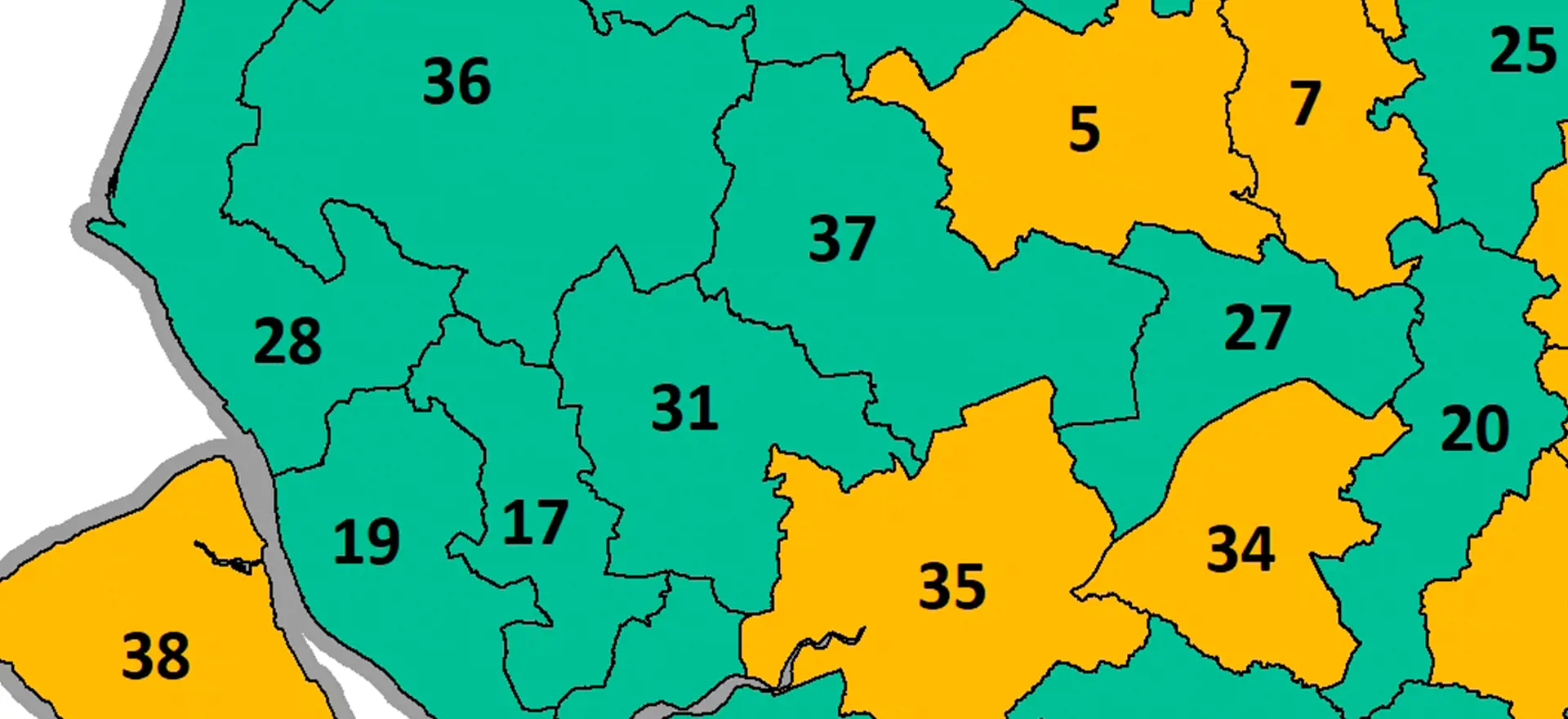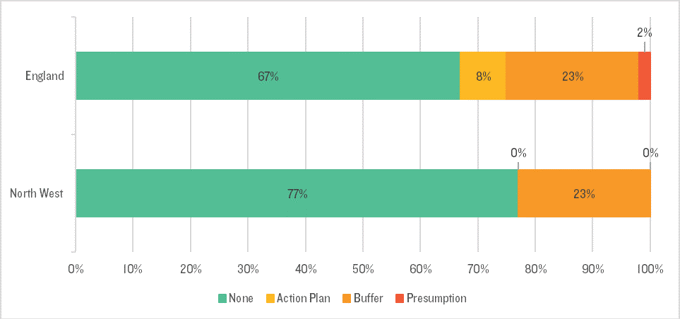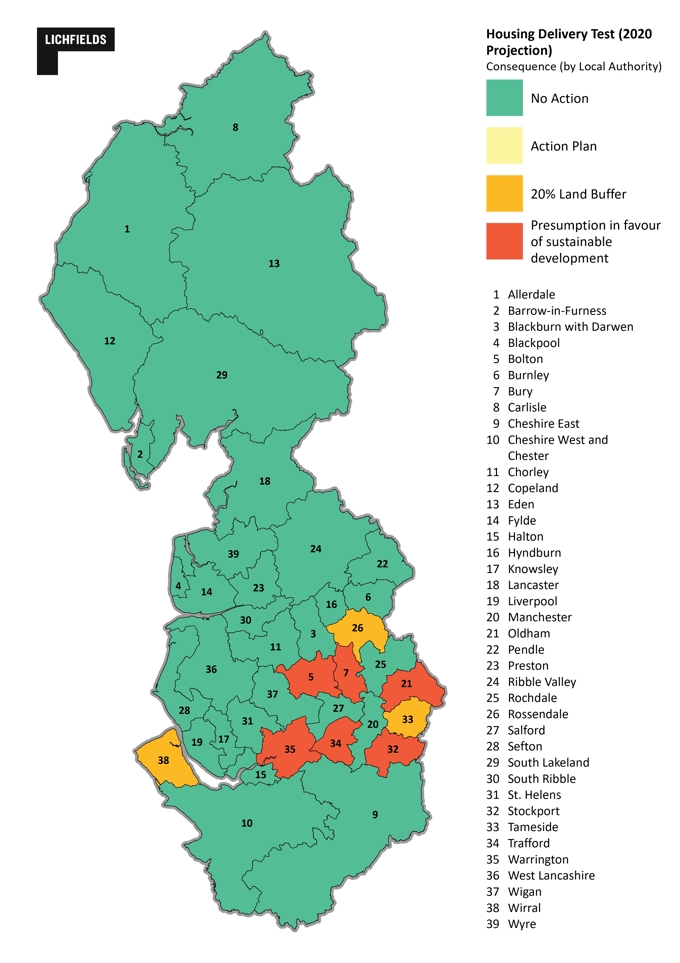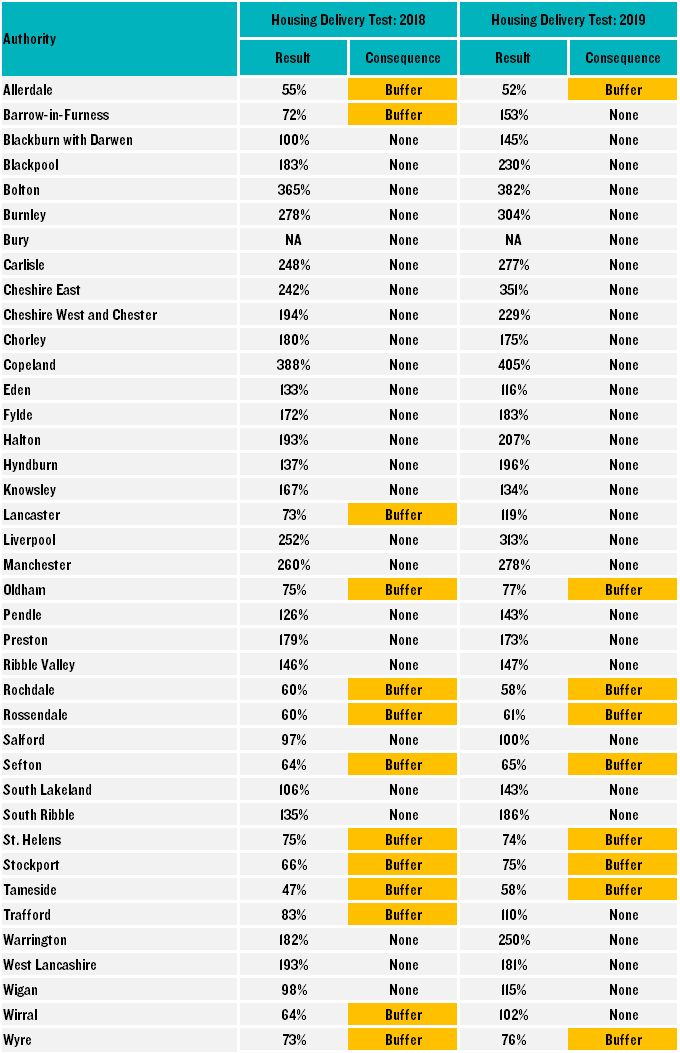
Housing Delivery Test 2019: The North West
Nicholas Mills
03 Mar 2020
The Housing Delivery Test (HDT) provides a snapshot of national and regional housing delivery in 2019 against the number of homes required over a rolling 3-year period. It also allows progress from 2018 to be monitored and changes predicted going forward. Crucially, it is more than just a monitoring tool and has far-reaching implications for many districts in the North West, with escalating planning sanctions applied depending on the scale of any shortfall.
It is worth noting at the outset that the HDT appears to be having some effect, with two thirds (26) of the North West’s 39 districts delivering more homes in 2018/19 than they did the previous year, with the overall level of delivery across the region as a whole increasing by 14%, from 26,305 in 2017/18 to 30,130 in 2018/19. However, the number of homes required to be delivered under the HDT also increased for all but 4 of the 39 districts in the same time period, with the overall need increasing by 11%. This, specifically when aligned with the increasing ‘presumption in favour’ threshold (in 2020 local authorities must deliver 75% of their requirement to avoid this presumption compared to 45% for 2019), means that an increasing number of North West authorities are at risk of losing control over unplanned development in their areas in the years to come.
North West Results
Key 2019 HDT results for the North West region published by the Government this month are:
- 77% of North West authorities are currently delivering sufficient levels of housing and require no action when measured against their housing requirement (defined as either the latest adopted housing requirement or the minimum annual local housing need figure/annual average household growth).
- No authorities require an Action Plan in isolation.
- 9 authorities require a 20% land buffer and an Action Plan.
- The presumption in favour of sustainable development is not triggered by any North West authority.
Key Changes 2018-2019
Key changes within the region from 2018 to 2019 are:
- Consequences have improved for Blackburn with Darwen, Pendle, Wigan and Sefton which have risen into a ‘no action’ position from having a previous 20% land buffer requirement.
- Consequences have not improved for Warrington, Rossendale, Bolton, Bury, Oldham, Stockport, Tameside, Trafford and Wirral where a 20% land buffer and Action Plan requirement still stands.
- Warrington, Bolton and Stockport fare particularly badly as the 2019 measurement is lower than the 2018 measurement.
- All other North West authorities remain within the same overall category as 2018, albeit some authorities have fared better than others.
Headline Messages
- The majority of North West authorities perform strongly, with some delivering housing significantly in excess of the 45% required in 2019 to avoid the presumption in favour of sustainable development ‘the NPPF footnote 7 threshold’. Whilst these include rural authorities that have a very low requirement, this also includes a number of urban authorities. For example, Burnley achieved 405% of its requirement; Cheshire West and Chester achieved 382%; Copeland 351%; Preston 313%; Allerdale 304%; Ribble Valley 278%; Carlisle 277%; Knowsley 250% and Cheshire East 230%.
- As noted above, housing delivery increased between 2018 to 2019 in most authorities. Those with the greatest increases were Copeland (109%), Blackburn with Darwen (81%), Knowsley (68%), and Preston (61%).
- A number of authorities continue to perform poorly and deliver insufficient levels of housing. A 20% land buffer and Action Plan requirement still stands in Warrington, Rossendale, Wirral and six of the ten the Greater Manchester (GM) authorities (Bolton, Bury, Oldham, Stockport, Tameside, Trafford).
- Among the stronger performing authorities in GM are Manchester and Salford. However, much of the supply in these authority areas comprises apartment development which may not address the wider mix of housing required across GM including family homes, affordable housing and executive homes. This issue is compounded by serious levels of under-delivery in most of the other GM authorities.
- Warrington was the worst performing North West authority, delivering only 52% of its needs over the past 3 years, whilst Bolton and Trafford were not far behind at 58% each.
- Overall, the Region is performing above the average for England, although a number of authorities continue to struggle.

2020 Predictions
The NPPF footnote 7 housing delivery threshold, whereby the presumption in favour of sustainable development will apply for decision taking, will increase from 45% of the housing requirement being delivered in 2019 to 75% being delivered in 2020. This could have serious consequences for several of the region’s authorities and could see them starting to lose control of unplanned development in their areas.
We cannot be certain how the 2020 HDT will look given that completions for 2019/20 may significantly increase/decrease for any given authority. The Government has also suggested that it may reconsider the basis for calculating LHN at some point in the near future. However, working on the basis that next year’s completion rate remains broadly in line with 2018/19, then the following implications for the North West region are likely to occur:
- Much of Greater Manchester is likely to continue to seriously under-deliver housing needs. Indeed, we estimate that 5 of the Greater Manchester authorities are at serious risk of falling below the 75% threshold that would mean that the presumption in favour of sustainable development would apply; these being Bolton, Bury, Oldham, Stockport and Trafford. Tameside would remain subject to a 20% land buffer and Action Plan requirement.
- The presumption in favour of sustainable development is also likely to be triggered in neighbouring Warrington.
- Rossendale and Wirral are likely to continue to require a 20% buffer and Action Plan.
- Cheshire, Cumbria and almost all of Lancashire are likely to be spared any further action from the Housing Delivery Test in 2019/20.

As the location of new development is restricted by Green Belt in the GM authority areas (as indeed it is in Warrington and Wirral) it is difficult to predict how the triggering of the presumption in favour of sustainable development would affect housing delivery in these areas. However, the emerging picture re-emphasises the need for the urgent delivery of an adopted spatial plan for GM in order to address the unmet need for market and affordable homes.







